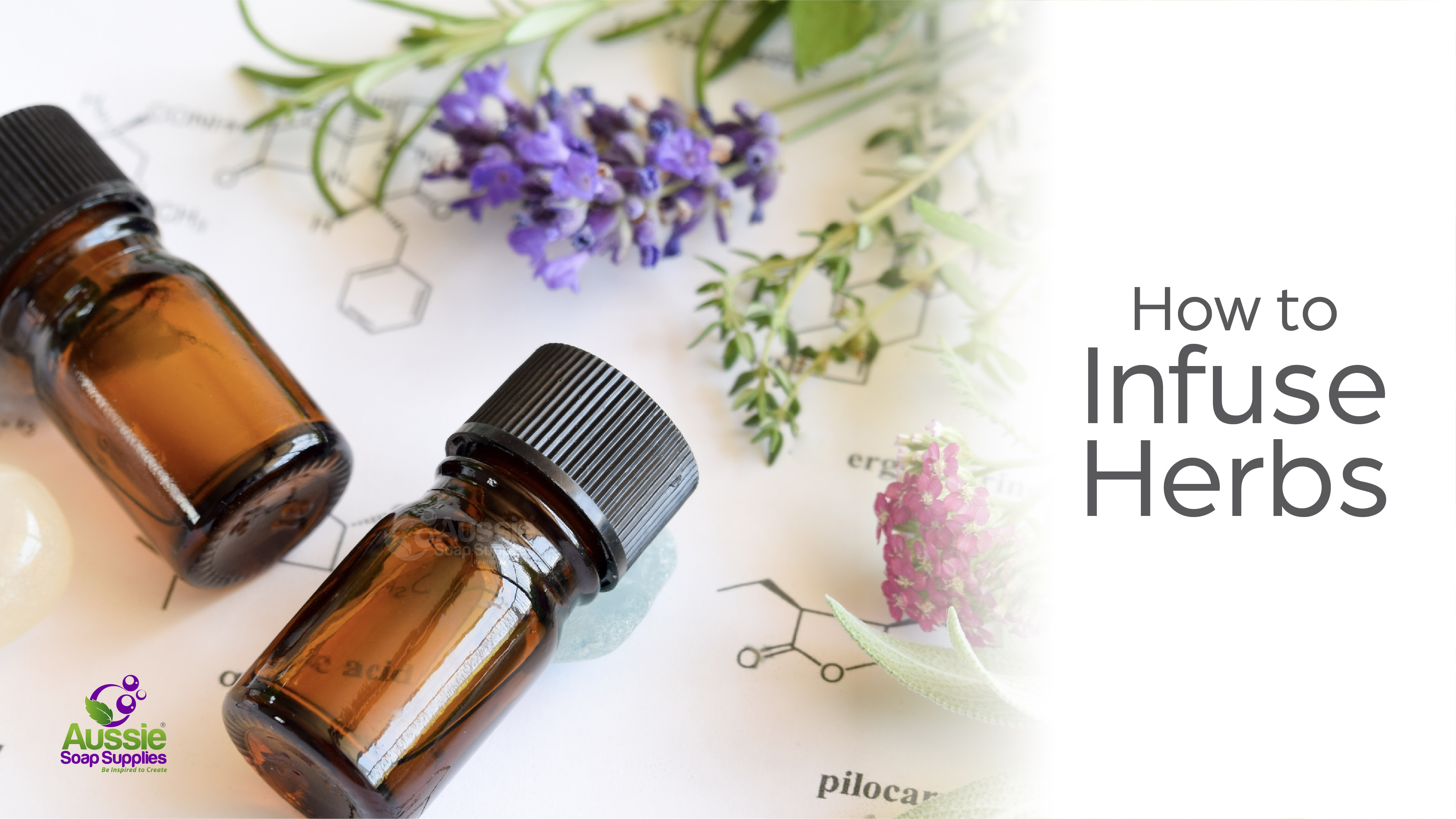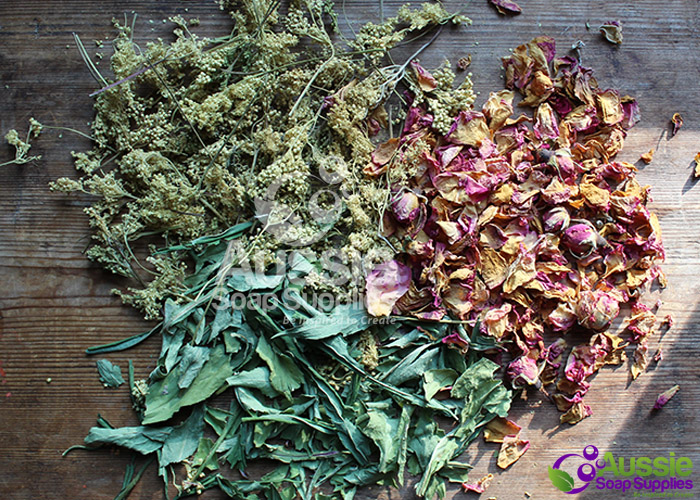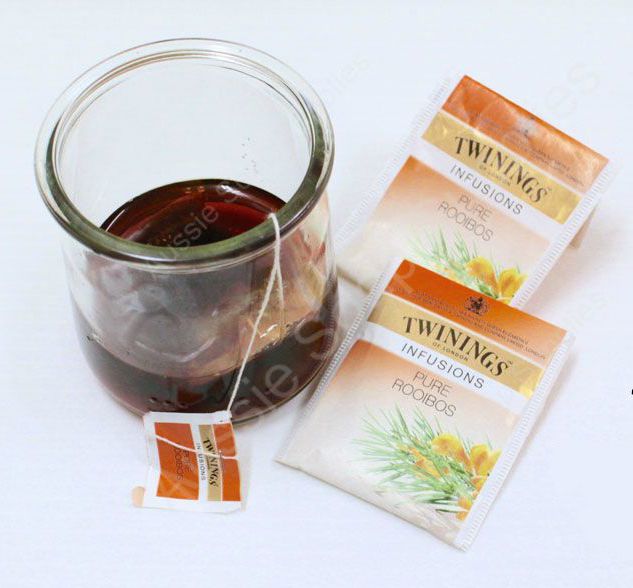
Herbal infusions have been made and used throughout history - both for their medicinal properties and culinary attributes. Our breakfast tea is, after all, simply an infusion of an herb infused in water. Herbal infusions can consist of just one individual herb, or can be made of two or more herbs blended together.
Infusing an herb in oil allows the active fat soluble constituents to be passed into the oil. Hot infused oils are slowly, simmered for a couple of hours, whilst cold infused oils are heated by the sun over several weeks. Both types of oil infusion can be used externally as a massage oil or added to creams and medicaments.
We generally use our herbal infusions (or herbal teas) for culinary purposes or as a base for our soap and moisturisers. Oil infused herbal brews we use in soap and medicinally for simple home remedies, or for colouring soap and adding their herbal properties to our soap such as in this Infused Calendula Soap. It is really important that your equipment is very clean when you start. Wipe down work surfaces and have storage containers ready. There are several methods to infuse into oil, and just incase, a quick tutorial to herbal teas/infusions. You can use a crockpot to heat oil and herbs, a cook top and saucepan or you can solar infuse the mixture.
Tips: If using powders such as alkanet or dried herbs which are very fine particles, we suggest using Large Heat Sealable Tea Bags for a no mess/fuss way of infusing, particularly when infusing for dye. Use about 1 tablespoon of herb material per large bag. If you overfill the teabags they will burst when the herbs expand with oil. Muslin Cotton Bags in Medium and Large are another option (and great for draining cheese too!) for infusions. You can also make your own out of Terylene Curtain material or Cheesecloth.
Scroll down to each method.
Infusing Fresh Herbs in Oil - Hot Infusion

- Herbs are best picked early in the day, before the sun has a chance to deplete some of those wonderful oils from the leaves. Ensure they are sand and grub free, and DRY, with no moisture on them (if you have rinsed them) and then place them somewhere inside on a clean cloth until slightly wilted. This helps to ensure that there is no surface water on the herbs when you infuse them.
- Place the herbs into a crockpot or saucepan.
- Pour in enough olive oil to cover the herbs plus approximately 2cm more.
- For Crockpot: Turn Crockpot to low and leave to infuse for 2 - 3 hours, checking periodically as you may need to turn it off and then back on again to avoid overheating. If you wish to strengthen the infusion, strain the oil from the herbs, and replace with fresh herbs and pour back the same oil and repeat the heating process to strengthen the infusion.
- For Cook Top: Place a heat diffuser matt (to avoid burning the mixture) on the heat source and turn to low. Check periodically to ensure the oil is not overheating and infuse for approximately 2 - 3 hours. If you wish to strengthen the infusion, strain the oil from the herbs, and replace with fresh herbs and pour back the same oil and repeat the heating process.
- I like to strain my infusions through cheesecloth or even pieces of terylene net curtain material. Place strainer over a clean bowl and line this with the cloth. Empty the herbs and oil and let it drain through. Then draw together the edges and twist to squeeze out as much oil as possible.
- Pour into a clean jar until ready for use (don't place the lid on until completely cool).
Infusing Dried Herbs in Oil - Hot Infusion
Use this method or the jar method regular dried leaf herbs, and also for colouring powders such as Alkanet Root Powder, Indigo Blue Powder, Madder Root Powder and Saffron Powder - for less mess use Large Heat Sealable Tea Bags.
- Place the herbs into a small crockpot (or medium saucepan if using a direct heat source such as a cook top).
- Pour in enough olive oil (or other liquid oil of choice) to cover the plant material plus approximately 2cm more.
- For Crockpot: Turn Crockpot to low and leave to infuse for 2 - 3 hours, checking periodically as you may need to turn it off and then back on again to avoid overheating. If you wish to strengthen the infusion, strain the oil from the herbs, and replace with fresh herbs and pour back the same oil and repeat the heating process to strengthen the infusion.
- For Cook Top: Place a heat diffuser matt (to avoid burning the mixture) on the heat source and turn to low. Check periodically to ensure the oil is not overheating and infuse for approximately 2 - 3 hours. If you wish to strengthen the infusion, strain the oil from the herbs, and replace with fresh herbs and pour back the same oil and repeat the heating process.
Jude's Cutting Corners Method for infusing colour for Cold Process Soap:
- Pour the oil into a clean jar until ready for use (don't place the lid on until completely cool).
- I use my "Cutting Corners Infusion Method" for infusing colours, such as indigo and madder for cold process soap. I do this when I am going to add the botanical material to the batch, not just a strained infusion. A few hours ahead of your soaping session, infuse the powder (such as indigo, madder, alkanet etc) You can even do this the night before if you are an early morning soaper! Remove approximately 30g of Olive Oil from the batch allocation and add 15g of botanical material into a glass beaker or jug. Remembering that Beakers are NOT high heat tolerant, warm the mixture gently in the microwave and medium in short bursts. When it's warm to touch, mix through the powder to remove any little dry spots or lumps. You can use a popstick, stirrer or mini mixer. Then allow the mixture to sit for an hour or so. Then I repeat this and leave it for a few hours.
Infusing Dried Herbs in Oil (Cold Infusion) - Jar Method 
If you don't want to have to watch the infusion for a couple of hours you can prepare an infusion by packing a glass jar with herbs and oil and using the sun for heat. I have always used the Moccona Jar as it is ideal, can be sterilised and is airtight. (I am sure other jars are fine too, but avoid jars with thin metal lids if possible.
- Jars should be VERY clean, it's easy to send them through the dishwasher, if you have one. If not, simply scald them with hot water. Air dry or use a warm oven to ensure they are completely dry before adding herbs and oil.
- It is best to USE DRIED HERBS for infusing this method - you can get some nasty mixtures if there is water in the infusion. However, if you really want to use your fresh herbs, wilt using the method above to ensure they are completely dry before packing into the jar.
- I like to use good quality olive oil for most of my infused oils.
- Pack the jar with the dried herbs and then fill with oil, allowing it to run right through the herbs.
- Seal with a clean lid (preferably plastic lined glass lid for cleanliness - like a Moccona coffee lid).
- Place the jar on a sunny windowsill for several weeks.
- Gently shake the jar each day and a few weeks you may remove the herbs and replace with new herbs and your once infused oil to strength the brew.
- I like to strain my infusions through cheesecloth or even pieces of terylene net curtain material. Place strainer over a clean bowl and line this with the cloth. Empty the herbs and oil and let it drain through. Then draw together the edges and twist to squeeze out as much oil as possible.
Infusing Herbs for Herbal Teas

If you can make a cup of tea, you can infuse herbs in water! Herbs infused in water are intended to be used or drunk immediately. If you are using the herbal infusion or tea, as part of your soap recipe, we suggest making a strong infusion, by using for example, 3 teabags instead of one. Then deduct this amount of water from the amount specified in the recipe.
A tip for infusing fresh herbs, try and avoid using a metal strainer/infuser ball, as this affects the constituents. Use nylon or a tea bag, or simply no bag, pop some fresh leaves straight into the cup!
- Boil the kettle!
- Place herbs/botanical material into cup or jug.
- Cover with water that has just boiled.
- Slip a plate over the jug to catch the steam.
- Voila! Herbal tea or infused herbal water for your cosmetics and soaps.

This concentrated infusion was for my Honeycomb Melt and Pour Loaf Project
Frangipani and Rose Petals Note: Most people growing roses and frangipani (plumeria) would love to infuse these, and I am one of those people! They are both notoriously difficult flowers to infuse, as they go slimy, and I have not come across anyone who has successfully infused these two wonderful scented flowers, so purchasing the pure oils ready for use is a better way to go.






